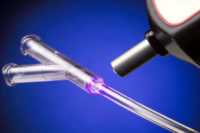Traditionally, aircraft engines generate an excessive amount of heat. Engineers are attempting to capture some of that wasted heat and convert it into electrical power with the aid of a thermoelectric generator.
Traditionally, aircraft engines generate an excessive amount of heat. European engineers are attempting to capture some of that wasted heat and convert it into electrical power with the aid of a thermoelectric generator.
A team of researchers EADS Innovation Works is exploring ways to use the temperature differences between the outside and the interior of an aircraft to produce electrical energy. The goal is to create enough energy to supply health monitoring sensors in the fuselage and transmit their data by radio to the cockpit. The aim of the project is to reduce maintenance costs, which account for up to 22 percent of an aircraft’s overall expenses per flight hour.
“A wireless sensor network that supplies itself with energy on location is a good solution to collecting maintenance-relevant data at a low cost,” says Dominik Samson, a member of the project team. This form of local energy production is called energy harvesting. It involves the conversion of unused available energy into usable (electrical) energy.
The EADS engineers are focusing on developing minimal amounts of energy for applications with very low consumption rates. “Saving energy is not our primary goal,” says Samson. “What we want to achieve is energy autonomy. We will save money by making systems independent of central electricity sources.”
Aircraft offer several possibilities for doing that. The energy harvesting team investigated various technologies, including solar cells, generators that produce energy out of vibrations, thermoelectric generators, radio waves, and laser-based and acoustic energy transmission. Out of all these options, the thermoelectricity method was found to be particularly promising. It involves converting heat flow into electrical power with the aid of a thermoelectric generator.
“This technology is particularly suitable, as major temperature differences occur in and around the aircraft,” says Samson. “There is the difference between the ambient air, with temperatures ranging from -20 to -50 C, and the passenger cabin with a temperature of 20 C, for example. Then there are also the strong temperature fluctuations on the outer skin after takeoff or during landing.”
In addition, an artificial temperature difference can be created anywhere on an aircraft’s outer skin. According to Samson, that’s done by connecting one side of a thermoelectric generator to a heat storage facility, while the other side is connected to the outer skin and cools down more quickly. The difference in temperature generates an electric current.
In deciding what to use as the heat storage medium, Samson and his colleagues identified water, because the liquid can store heat for a particularly long period of time. Small hemispheres filled with water are adhered to the inside of the aircraft wall, forming the most noticeable part of a health monitoring sensor node.
“A special mechanism is also needed to transform the generated voltage into a value suitable for the sensor,” explains Samson. “This is known as power management. The system also has to buffer energy so that phases without energy production can be bridged.”
The system developed by the EADS engineers has been tested in a climate chamber. “Given an energy consumption of several milliwatts at the sensor node, the amount of energy produced and stored during the flight is sufficient to reliably operate the sensor node,” says Samson. “It is also enough for long-haul flights, as the health monitoring sensors do not need to be active all the time, and the sensor nodes are consumption-optimized. By comparison, a typical light-emitting diode consumes 20 to 50 milliwatts.
“Energy harvesting could conceivably be applied to other sectors, too,” Samson points out. “Industrial machines and domestic appliances are just two examples. Energy harvesting can give machines of all kinds an artificial nervous system.”
Recommended Articles
Related Articles
×
Never miss the latest news and trends driving the manufacturing industry
Stay in the know on the latest assembly trends.
JOIN TODAY!Copyright ©2024. All Rights Reserved BNP Media.
Design, CMS, Hosting & Web Development :: ePublishing




